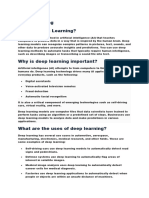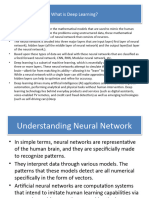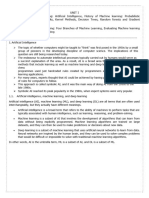0% found this document useful (0 votes)
28 views34 pagesLec 1 - Deep - Learning - Introduction
The document provides an introduction to deep learning, covering its definition, key concepts, and differences from traditional machine learning. It discusses various neural network architectures, applications, limitations, and tools for implementation. Additionally, it highlights the future of deep learning, including advancements and ethical considerations.
Uploaded by
hiramughalCopyright
© © All Rights Reserved
We take content rights seriously. If you suspect this is your content, claim it here.
Available Formats
Download as PPTX, PDF, TXT or read online on Scribd
0% found this document useful (0 votes)
28 views34 pagesLec 1 - Deep - Learning - Introduction
The document provides an introduction to deep learning, covering its definition, key concepts, and differences from traditional machine learning. It discusses various neural network architectures, applications, limitations, and tools for implementation. Additionally, it highlights the future of deep learning, including advancements and ethical considerations.
Uploaded by
hiramughalCopyright
© © All Rights Reserved
We take content rights seriously. If you suspect this is your content, claim it here.
Available Formats
Download as PPTX, PDF, TXT or read online on Scribd
/ 34

























































































